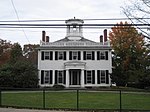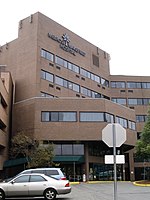Wyoming Hill station
Buildings and structures in Melrose, MassachusettsMBTA Commuter Rail stations in Middlesex County, MassachusettsMassachusetts Bay Transportation Authority stubsMassachusetts railway station stubsRailway stations in the United States opened in 1845

Wyoming Hill is an MBTA Commuter Rail station on the Haverhill Line, located in Wyoming Square near downtown Melrose, Massachusetts. The station has two low-level side platforms and is not accessible. Wyoming Hill, in addition to the two other commuter rail stops in Melrose, was originally intended to be an extension of the Orange Line further north to Reading, Massachusetts.
Excerpt from the Wikipedia article Wyoming Hill station (License: CC BY-SA 3.0, Authors, Images).Wyoming Hill station
West Wyoming Avenue,
Geographical coordinates (GPS) Address Nearby Places Show on map
Geographical coordinates (GPS)
| Latitude | Longitude |
|---|---|
| N 42.4519 ° | E -71.0694 ° |
Address
Wyoming Hill
West Wyoming Avenue
02176
Massachusetts, United States
Open on Google Maps









